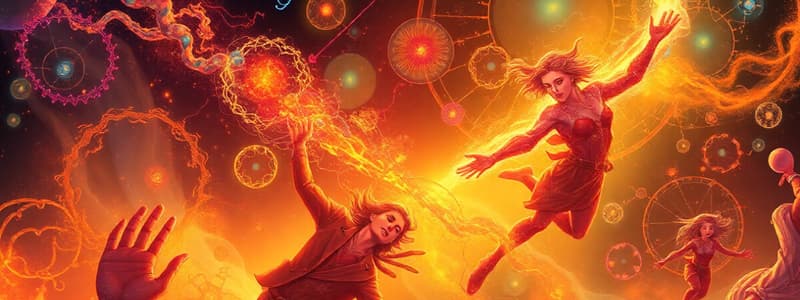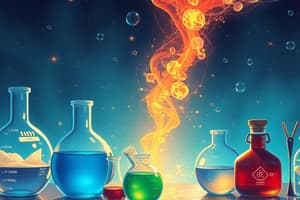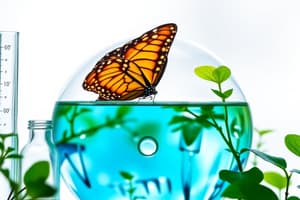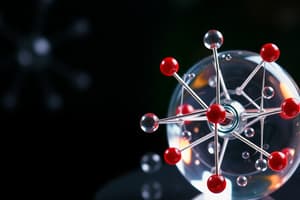Podcast
Questions and Answers
Which of the following carbohydrates is primarily used for structural support in plant cell walls?
Which of the following carbohydrates is primarily used for structural support in plant cell walls?
- Cellulose (correct)
- Starch
- Sucrose
- Glycogen
A scientist is studying a molecule that contains a long hydrocarbon chain with primarily single bonds and is solid at room temperature. Which type of lipid is this MOST likely to be?
A scientist is studying a molecule that contains a long hydrocarbon chain with primarily single bonds and is solid at room temperature. Which type of lipid is this MOST likely to be?
- Unsaturated fat
- Saturated fat (correct)
- Steroid
- Phospholipid
During protein synthesis, a mutation occurs that changes a codon from encoding an amino acid to a stop codon. Which level of protein structure will be MOST directly affected?
During protein synthesis, a mutation occurs that changes a codon from encoding an amino acid to a stop codon. Which level of protein structure will be MOST directly affected?
- Tertiary structure
- Primary structure (correct)
- Quaternary structure
- Secondary structure
A segment of DNA has the sequence 5'-ATTGCA-3'. What is the sequence of the complementary strand?
A segment of DNA has the sequence 5'-ATTGCA-3'. What is the sequence of the complementary strand?
Which of the following structures is NOT found in bacterial cells?
Which of the following structures is NOT found in bacterial cells?
A researcher observes a cell actively synthesizing large amounts of lipids. Which organelle is MOST likely to be abundant in this cell?
A researcher observes a cell actively synthesizing large amounts of lipids. Which organelle is MOST likely to be abundant in this cell?
Which of the following BEST describes the function of the proteins embedded in the cell membrane according to the fluid mosaic model?
Which of the following BEST describes the function of the proteins embedded in the cell membrane according to the fluid mosaic model?
An enzyme's activity is significantly reduced when a molecule binds to a site distinct from the active site, altering the enzyme's shape. This is an example of what?
An enzyme's activity is significantly reduced when a molecule binds to a site distinct from the active site, altering the enzyme's shape. This is an example of what?
A researcher observes that plants grow taller in sunny locations compared to shady ones. Which of the following is the most appropriate next step in applying the scientific method?
A researcher observes that plants grow taller in sunny locations compared to shady ones. Which of the following is the most appropriate next step in applying the scientific method?
Which of the following correctly lists the levels of biological organization from simplest to most complex?
Which of the following correctly lists the levels of biological organization from simplest to most complex?
An atom has 6 protons, 7 neutrons, and 6 electrons. What are its atomic number and atomic weight, respectively?
An atom has 6 protons, 7 neutrons, and 6 electrons. What are its atomic number and atomic weight, respectively?
If an atom loses an electron, what type of ion does it become, and what is the nature of its net charge?
If an atom loses an electron, what type of ion does it become, and what is the nature of its net charge?
Water is essential for life because of its unique properties. Which of the following properties of water is most directly responsible for its ability to moderate temperature?
Water is essential for life because of its unique properties. Which of the following properties of water is most directly responsible for its ability to moderate temperature?
A solution has a pH of 3. Which of the following statements best describes this solution?
A solution has a pH of 3. Which of the following statements best describes this solution?
Which of the following reactions involves the addition of water to break down a polymer into its constituent monomers?
Which of the following reactions involves the addition of water to break down a polymer into its constituent monomers?
Which component of an amino acid distinguishes it from other amino acids?
Which component of an amino acid distinguishes it from other amino acids?
Flashcards
Homeostasis
Homeostasis
Maintenance of a stable internal environment.
Hypothesis
Hypothesis
A testable explanation for a phenomenon.
Independent Variable
Independent Variable
The component of an experiment that is changed by the researcher.
Levels of Complexity in Life
Levels of Complexity in Life
Signup and view all the flashcards
Atomic Number
Atomic Number
Signup and view all the flashcards
Ion
Ion
Signup and view all the flashcards
Polar Covalent Bond
Polar Covalent Bond
Signup and view all the flashcards
Buffer
Buffer
Signup and view all the flashcards
Glucose
Glucose
Signup and view all the flashcards
Sucrose
Sucrose
Signup and view all the flashcards
Glycogen
Glycogen
Signup and view all the flashcards
Starch
Starch
Signup and view all the flashcards
Cellulose
Cellulose
Signup and view all the flashcards
Amino Acids
Amino Acids
Signup and view all the flashcards
Competitive Inhibition
Competitive Inhibition
Signup and view all the flashcards
Non-Competitive Inhibition
Non-Competitive Inhibition
Signup and view all the flashcards
Study Notes
- Exam 1 consists of multiple choice, true-false, and matching questions.
Scientific Study of Life
- Understand all the characteristics of life, including examples of homeostasis.
- Familiarize with the scientific method's steps; identify hypotheses, variables, theories, and control experiments within experiments; distinguish between independent and dependent variables.
- Know the complexity levels in life’s order, progressing from atoms to the ecosystem and then the biosphere.
- Differentiate between a cell, tissue, organ, organ system, and organism, with examples such as a group of cells forming a tissue.
The Chemistry of Life
- Recognize an atom and its components: protons, electrons, and neutrons.
- Know electron roles and orbitals and their influence on an atom's chemical properties.
- Distinguish between atomic number (number of protons or electrons) and atomic weight (number of protons plus neutrons); for instance, an atom with 8 protons, 8 electrons, and 7 neutrons has an atomic number of 8 and an atomic weight of 15.
- Understand ions and isotopes, including radioactive isotopes and their uses in medicine and studying fossils.
- Identify ionic, covalent (polar and nonpolar), and hydrogen bonds, with examples like sodium chloride (ionic).
- Differentiate between polar and nonpolar molecules, noting water's polarity and its hydrophilic nature.
- Differentiate hydrophilic and hydrophobic substances.
- Understand water's unique properties.
- Know the pH scale (acidic, basic, neutral) and buffers, understanding how hydrogen (H+) or hydroxide (OH-) ion concentrations define acidity and alkalinity.
- Differentiate hydrolysis and dehydration reactions.
- Know macromolecules (polymers) and their components (monomers), such as proteins being made o amino acids- amino acids are monomers or subunits of proteins, and the structure of amino acids (the R group varies, the carboxyl and amino group which are always the same in every amino acid)
- Nucleic acids are made of nucleotides; therefore, nucleotides are the subunits of nucleic acid.
- Understand what a peptide bond is.
- Define carbohydrates such as glucose, sucrose, glycogen, starch, cellulose, and chitin and know which ones are energy storage and which ones have a structural role; note chitin and cellulose as structural carbohydrates and their location in cells and organisms.
- Differentiate between saturated and unsaturated fats, and examples of lipids such as phospholipids and steroids.
- Remember the different structures of proteins: primary, secondary, tertiary, and quaternary.
- Difference between DNA and RNA, including their functions, the base pairing rules in DNA (A-T, G-C), and RNA (Uracil replaces Thymine).
- Determine the complementary sequence; for example, the sequence GGAATT is complemented by CCTTAA.
Cell Structure and Function
- Distinguish between prokaryotic and eukaryotic cells.
- Compare bacteria, plant, and animal cells regarding organelles like the nucleus, mitochondria, chloroplast, cell wall, lysosomes, endoplasmic reticulum, ribosome, cilia, flagella, microtubules, centrioles, and chromosomes.
- Know functions of organelles such as the nucleus, mitochondria, chloroplast, cell wall, lysosomes, Golgi body, endoplasmic reticulum, ribosome, cilia, flagella, cytoskeleton, microtubules, centrioles, and chromosomes.
- The structural and functional differences between rough and smooth endoplasmic reticulum, ribosome function, and why rough ER is named as such.
- Understand cytoplasmic movement (cyclosis).
- The cell membrane consists of a phospholipid bilayer- major component. Cell membranes also have proteins.
- Fluid mosaic model refers to part of the cell structure; know its meaning.
- Know the various functions of proteins in cell membranes.
The Energy of Life
- Understand potential and kinetic energy, noting that sugars or fat molecules possess potential energy.
- Define metabolism.
- Describe the laws of thermodynamics, differentiating between the first and second laws.
- Understand ATP's structure and function.
- How enzymes function regarding activation energy.
- Differences between an enzyme's active site and its substrate.
- Feedback inhibition (competitive and non-competitive inhibition).
- Factors affecting enzyme activity, like pH and temperature.
- Know coenzymes, such as NAD.
- Understand different cellular transport systems: osmosis, diffusion, facilitated diffusion, active transport (e.g., the sodium-potassium pump), endocytosis, exocytosis, pinocytosis, and phagocytosis.
- Isotonic, hypertonic, and hypotonic environments, and the impact on cells, with examples like red blood cells in water or 10% salt solutions.
Studying That Suits You
Use AI to generate personalized quizzes and flashcards to suit your learning preferences.
Related Documents
Description
Explore life's characteristics and homeostasis. Learn the scientific method's steps, and variables. Discover life's complexity levels, from atoms to the biosphere, and grasp atomic structure, electron behavior, and chemical properties.




